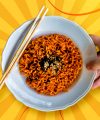Table Of Content
- Is Kimbap the Same as Sushi?
- What Is the History of Japanese Sushi?
- What Are the Ingredients Used?
- How To Make Sushi: The Steps to Follow
- What Is the History of Kimbap?
- What Are the Ingredients Used?
- How To Make Kimbap: The Steps to Follow
- Similarities Or Differences: Clarifying The Japanese Sushi vs Kimbap Battle
- What Are the Health Benefits of Sushi and Kimbap?
- Where To Get The Ingredients From?
Listen up, everyone, I’m a little mad today. I’ve been in this mood since yesterday, and I’d like to share it with all of you. Let me take you all on a trip down memory lane!
I was intensely craving some raw, marinated crab Kimbap for dinner last night, but I was a little too sick to get it myself. So, I asked my sister to get it for me.
Guess what she did! She killed my dreams and bought me a fish roe Sushi instead! Well, not that I was too unhappy; the fish roe was delicious!
This made me realize that many people cannot differentiate between Japanese and Korean cultures; it can be as simple as food, as complex as a tradition, or something else.
As both cultures are Asian, and during the Korean War, they were in close proximity for a long time, the line that separates them is now thin.
Here is the point where I remind my friends: Don’t worry, I’m here to save the day. In this article, I will discuss the ultimate debate of Japanese Sushi vs Kimbap, which should help clarify your understanding. Let’s start!
Is Kimbap the Same as Sushi?

This question forms the foundation of the debate over Japanese Sushi versus Kimbap. And the answer is no, although Kimbap and Sushi might look extremely similar, they are not the same.
If you look carefully, there are various nuances that separate Kimbap from Sushi, even if you’re not aware of the huge cultural differences.
What Is the History of Japanese Sushi?

In ancient Japan, a practice of fish preservation existed that utilized rice as a preservative.
People would either ferment a whole fish in rice (sugata Sushi) or mix the fish with rice and then ferment it (kirimi Sushi).
Essentially, the word “Sushi” means “sour” or “fermented” rice. Depending on the flavors you tend to choose, the ingredients used in your Sushi vary.
What Are the Ingredients Used?
The ingredients typically used include rice, Sushi vinegar, salt, and pepper. The common toppings that are generally used are-
- You can use fish such as yellowtail, salmon, and tuna
- Using seafood is an excellent choice for toppings. You can choose cooked octopus, Eel, or Unagi; squid sashimi is a favored option.
- You can also use vegetables such as daikon radish, carrots, avocado, etc.
- Lastly, use White soy sauce as a dip.
How To Make Sushi: The Steps to Follow
Making Sushi at home should be declared an art form. The whole procedure requires such precision and patience that it’s almost as if I am recreating the Mona Lisa.
Let us simplify the steps for you, lovely people, shall we?
- You can start the process by placing a nori sheet on a bamboo mat lined with plastic wrap.
- After that, you have to evenly distribute a handful of rice over the nori, leaving an inch gap at the top.
- Once done, you can arrange your desired fillings in a straight line down the center of the rice.
- Now you have to use the bamboo mat, roll the Sushi away from you. Always ensure that you are maintaining a tight grip. Moisten the edge of the nori to seal the roll.
- After that, using a wet knife, cut the roll into bite-sized pieces.
- Now your Sushi is all ready. You can serve alongside soy sauce, wasabi, and pickled ginger. Enjoy your Sushi!
During the mid-Edo period, fermented rice with vinegar, also known as Sumeshi, was introduced, which led to the evolution of a type of Sushi called Haya Sushi.
This method drastically reduced the fermentation time, allowing people to eat the rice alongside the fish.
During this period, a customer requested a presentation of mackerel Sushi, where the fish is sliced thinly and layered over the rice. Thus, maki Sushi was discovered.
What Is the History of Kimbap?

Also known as Gimbap, Kimbap is a rice roll wrapped in seaweed (gim) and filled with rice (bap).
The filling consists of various vegetables, proteins of your choice, and, most importantly, pickled vegetables. It is then cut into bite-sized pieces.
What Are the Ingredients Used?
The ingredients typically used in Kimbap include sesame oil, salt, dried seaweed, and rice. Except for this, it’s just a blank canvas that you can decorate with anything you like!
- You can use vegetables such as carrots, cucumbers, and spinach.
- Try incorporating some protein in it; the most favored choices are tuna or beef.
- Pickled vegetables, such as radishes, bok choy, and spring onions, are great.
- You can also add omelet strips and cheese, if you want.
How To Make Kimbap: The Steps to Follow
- Rinse and parboil spinach in boiling water for 30 seconds to 1 minute, then drain and rinse with cold water. Squeeze out excess water, then mix with 1/8 teaspoon salt and 1/2 tablespoon sesame oil in a bowl.
- Preheat a pan, add a dash of cooking oil, and cook a beaten egg on both sides over medium heat. Remove and cut into strips.
- Lightly cook carrots, crab sticks, and Kimbap ham separately in a heated pan for about 1 minute each.
- Mix the cooked rice with 1/2 tablespoon of sesame oil and 1/4 teaspoon of fine sea salt in a bowl.
- Set up all the Kimbap ingredients at a rolling station for easy assembly.
- Place a dried seaweed sheet on a bamboo mat, shiny side down. Spread rice over two-thirds of the seaweed, leaving a 5cm (2-inch) gap at the top.
- Fill the seaweed with the prepared ingredients evenly.
Similarities Or Differences: Clarifying The Japanese Sushi vs Kimbap Battle
There are both similarities and differences between Sushi and Kimbap. When the Japanese invaded Korea, they adopted the concept of Sushi and adapted it to their taste.
Although Sushi, especially Maki Sushi, has deeply influenced the concept of Kimbap, the debate remains ongoing, as Koreans have traditionally wrapped their rice in Seaweed strips.
| Similarities | Differences |
|---|---|
| Sushi as well as Kimbap require cooked rice as their base. Both of these use short-grain sticky rice. Furthermore, both of these recipes use seaweed to wrap the rice. Both these dishes allow you to choose your fillings from a variety of options. | The rice in Sushi is mixed with rice vinegar or Sushi vinegar to ferment it, while in Kimbap, it is simply mixed with sesame oil for texture. While the rice is wrapped in a seaweed sheet for Sushi, in Kimbap, the Seaweed sheet stays outside. Sushi typically features seafood, often raw, while Kimbap can include a variety of vegetables, meats, and even pickled ingredients. |
What Are the Health Benefits of Sushi and Kimbap?

Both Japanese Sushi and Kimbap offer certain health benefits, making them delectable yet healthy food options in Japan and South Korea. The benefits of these dishes are-
- Both Japanese Sushi and Kimbap are excellent sources of Omega-3 Fatty acids. The fish in Sushi, especially fatty fish like salmon and tuna, is packed with omega-3s, which are beneficial for heart health, brain function, and reducing inflammation.
- They are also excellent powerhouses of antioxidants, as both vegetables and Seaweed are packed with antioxidants. It reduces the risk of chronic diseases.
- Both these dishes are also extremely low in calories, which is why they don’t promote obesity in any way.
Where To Get The Ingredients From?
Now, you must be wondering how to obtain the ingredients involved. Most people have raised this concern with me that they want to create these recipes at home, but they are not sure where to buy the ingredients from.
You can obtain these ingredients quickly and without any hassle. Nowadays, most convenience stores store Korean and Japanese products, due to their growing demand.
Additionally, Asian convenience stores are being opened, which often feature ingredients that are staples in any Asian cuisine.
Even if these are not your forte, I am listing a few brands or platforms from where you can purchase these products-
- Seoul Store India
- Amazon. in
- Ubuy India
- Glocery
- UMAI
- SeelaMart
There you go, peeps! I won’t bother you anymore while you create these and many more amazing Japanese and Korean dishes. Do share your experience in the comment box below!
ADDITIONAL READING:












